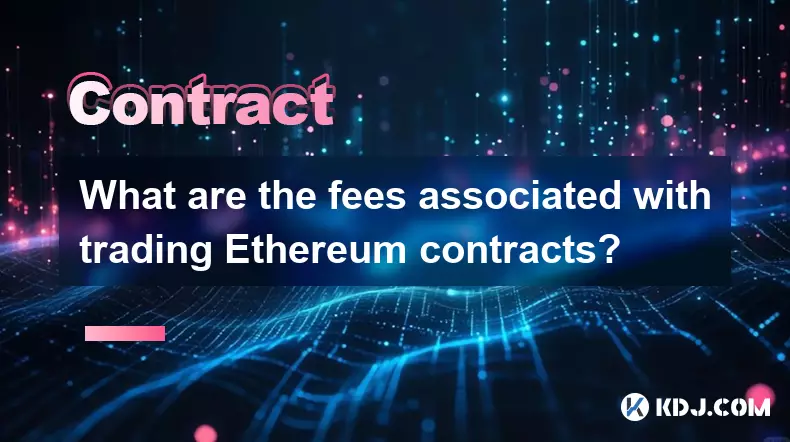-
 bitcoin
bitcoin $122288.232522 USD
0.16% -
 ethereum
ethereum $4480.662914 USD
-0.22% -
 xrp
xrp $2.962747 USD
-2.32% -
 tether
tether $1.000120 USD
-0.05% -
 bnb
bnb $1145.654223 USD
-2.07% -
 solana
solana $227.105217 USD
-1.67% -
 usd-coin
usd-coin $0.999548 USD
-0.02% -
 dogecoin
dogecoin $0.250875 USD
-2.04% -
 tron
tron $0.340654 USD
-0.49% -
 cardano
cardano $0.837968 USD
-2.52% -
 hyperliquid
hyperliquid $48.960449 USD
0.06% -
 chainlink
chainlink $22.049280 USD
-1.33% -
 ethena-usde
ethena-usde $1.000404 USD
0.02% -
 sui
sui $3.586212 USD
0.20% -
 avalanche
avalanche $29.894916 USD
-4.18%
What are the fees associated with trading Ethereum contracts?
Ethereum contract trading involves gas fees, exchange fees, and slippage, with costs varying by network congestion, platform, and trade complexity.
Oct 04, 2025 at 11:18 am

Fees Involved in Ethereum Contract Trading
1. Trading Ethereum-based contracts on various platforms incurs multiple types of fees that traders must account for to optimize their strategies and preserve capital. These fees are not limited to simple transaction costs but extend into layers of network, exchange, and execution-related charges.
2. The most visible cost is the gas fee, which refers to the amount paid in ETH to compensate miners or validators for processing transactions on the Ethereum blockchain. When executing smart contract interactions—such as opening or closing a derivatives position—users must pay gas based on network congestion and computational complexity.
3. Centralized exchanges often charge taker and maker fees depending on whether an order removes liquidity from the market (taker) or adds it (maker). These fees typically range from 0.02% to 0.1% per trade, though high-volume traders can qualify for rebates or reduced rates.
4. Decentralized platforms may layer additional protocol fees on top of base gas costs. For instance, certain DeFi derivatives protocols impose a small percentage fee on each trade to fund insurance pools or distribute rewards to liquidity providers.
5. Withdrawal fees also apply when moving funds off an exchange or out of a smart contract vault. These vary significantly across platforms and can be fixed amounts or dynamic based on blockchain load.
Gas Fees and Network Dynamics
1. Gas prices fluctuate in real time according to demand on the Ethereum network. During periods of high activity—such as major token launches or NFT mints—gas prices can spike dramatically, making contract interactions expensive.
2. Users interacting with Ethereum contract trading platforms must monitor gwei levels, which represent the price per unit of gas. Tools like Etherscan’s gas tracker help anticipate optimal times for executing trades.
3. Layer 2 solutions such as Arbitrum, Optimism, and zkSync reduce gas expenses by batching transactions off-chain before settling them on Ethereum. While interaction fees still exist, they are substantially lower than those on the mainnet.
4. Some Layer 2 platforms implement their own fee structures, where users pay in ETH or native tokens. Despite this, total costs remain far below equivalent mainnet operations.
5. Dynamic block space competition means that even minor delays in transaction confirmation can result in higher effective fees if traders choose faster processing speeds.
Exchange-Specific Fee Structures
1. Major centralized exchanges like Binance, Bybit, and OKX offer tiered fee models based on 30-day trading volume and platform token holdings (e.g., holding BNB reduces fees on Binance).
2. Futures contracts on these platforms usually involve separate funding rates, which are periodic payments exchanged between long and short positions to align futures prices with spot values. While not a direct fee, negative funding can erode profits over time.
3. Depositing collateral for leveraged positions may trigger fees, especially when transferring assets from external wallets. Transfers within the same exchange ecosystem generally avoid such costs.
4. Hidden slippage costs arise during volatile markets when large orders execute at less favorable prices than expected. Though not a listed fee, slippage impacts net returns similarly to explicit charges.
5. Some exchanges advertise zero-fee trading but compensate through wider bid-ask spreads or less transparent pricing mechanisms, effectively embedding costs into trade execution.
Minimizing Unnecessary Costs
1. Traders can use limit orders instead of market orders to control execution price and reduce exposure to sudden spikes in slippage or gas costs.
2. Scheduling non-urgent contract interactions during low-network-usage hours—often mid-week outside of U.S. business hours—can lead to significant savings on gas.
3. Utilizing Layer 2 networks for contract trading eliminates much of the financial burden associated with Ethereum mainnet usage while maintaining security guarantees.
4. Consolidating multiple small trades into fewer larger ones reduces the relative impact of fixed transaction fees, improving cost efficiency.
5. Regularly auditing wallet and exchange fee settings ensures that users aren’t inadvertently paying elevated rates due to outdated configurations or missed discount opportunities.
Frequently Asked Questions
Q: Are gas fees the same for all Ethereum contract trades?A: No. Gas fees vary depending on the complexity of the smart contract function being called. Opening a simple perpetual position consumes less gas than executing a multi-step options strategy involving several contract calls.
Q: Do decentralized exchanges charge maker-taker fees?A: Most do not use traditional maker-taker models. Instead, DEXs rely on automated market makers and charge a flat swap fee, typically between 0.05% and 1%, depending on the pool. Additional fees may go to liquidity providers.
Q: Can I predict my total fee before confirming a trade?A: On centralized platforms, displayed fees usually include taker/maker rates and funding adjustments. On-chain, wallets show estimated gas costs in ETH before confirmation, though final amounts may vary slightly based on actual block inclusion.
Q: Why do some trades have unexpectedly high fees even during calm market conditions?A: Complex contract logic, reverts due to failed transactions (which consume gas), or using inefficient routing paths on DEX aggregators can inflate costs despite low network congestion.
Disclaimer:info@kdj.com
The information provided is not trading advice. kdj.com does not assume any responsibility for any investments made based on the information provided in this article. Cryptocurrencies are highly volatile and it is highly recommended that you invest with caution after thorough research!
If you believe that the content used on this website infringes your copyright, please contact us immediately (info@kdj.com) and we will delete it promptly.
- BlockDAG, DOGE, HYPE Sponsorship: Crypto Trends Shaping 2025
- 2025-10-01 00:25:13
- Deutsche Börse and Circle: A StableCoin Adoption Powerhouse in Europe
- 2025-10-01 00:25:13
- BlockDAG's Presale Buzz: Is It the Crypto to Watch in October 2025?
- 2025-10-01 00:30:13
- Bitcoin, Crypto, and IQ: When Genius Meets Digital Gold?
- 2025-10-01 00:30:13
- Stablecoins, American Innovation, and Wallet Tokens: The Next Frontier
- 2025-10-01 00:35:12
- NBU, Coins, and Crypto in Ukraine: A New Yorker's Take
- 2025-10-01 00:45:14
Related knowledge

What is the difference between futures and perpetual contracts for Bitcoin?
Oct 02,2025 at 11:54pm
Understanding Bitcoin Futures Contracts1. Bitcoin futures are derivative instruments that allow traders to speculate on the future price of Bitcoin at...

What is the best time to trade PEPE contracts?
Oct 03,2025 at 11:54am
Understanding PEPE Contract Volatility1. PEPE contracts exhibit extreme price fluctuations due to their meme-based nature and low market cap. Trading ...

What are the common mistakes to avoid with Bitcoincoin contracts?
Oct 03,2025 at 08:54am
Emerging Trends in the Cryptocurrency Market1. Decentralized finance (DeFi) platforms continue to expand their influence across the blockchain ecosyst...

What is the maintenance margin for Bitcoin contracts?
Oct 02,2025 at 01:36am
Decentralized Exchanges Gain Momentum in 20241. Decentralized exchanges (DEXs) have seen a significant rise in trading volume, surpassing centralized ...

How to use technical analysis for trading XRP contracts?
Oct 03,2025 at 01:18pm
Understanding Price Patterns in XRP Futures1. Identifying chart patterns such as triangles, head and shoulders, and double tops or bottoms can provide...

What does "longing" PEPE contracts mean?
Oct 03,2025 at 11:54pm
Understanding Decentralized Exchanges in the Crypto Ecosystem1. Decentralized exchanges (DEXs) operate without a central authority, allowing users to ...

What is the difference between futures and perpetual contracts for Bitcoin?
Oct 02,2025 at 11:54pm
Understanding Bitcoin Futures Contracts1. Bitcoin futures are derivative instruments that allow traders to speculate on the future price of Bitcoin at...

What is the best time to trade PEPE contracts?
Oct 03,2025 at 11:54am
Understanding PEPE Contract Volatility1. PEPE contracts exhibit extreme price fluctuations due to their meme-based nature and low market cap. Trading ...

What are the common mistakes to avoid with Bitcoincoin contracts?
Oct 03,2025 at 08:54am
Emerging Trends in the Cryptocurrency Market1. Decentralized finance (DeFi) platforms continue to expand their influence across the blockchain ecosyst...

What is the maintenance margin for Bitcoin contracts?
Oct 02,2025 at 01:36am
Decentralized Exchanges Gain Momentum in 20241. Decentralized exchanges (DEXs) have seen a significant rise in trading volume, surpassing centralized ...

How to use technical analysis for trading XRP contracts?
Oct 03,2025 at 01:18pm
Understanding Price Patterns in XRP Futures1. Identifying chart patterns such as triangles, head and shoulders, and double tops or bottoms can provide...

What does "longing" PEPE contracts mean?
Oct 03,2025 at 11:54pm
Understanding Decentralized Exchanges in the Crypto Ecosystem1. Decentralized exchanges (DEXs) operate without a central authority, allowing users to ...
See all articles










































































